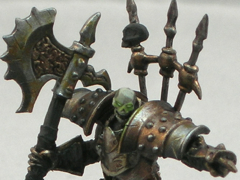
In the miniature painting community, there are two broad types of approaches to representing metallic surfaces, “non-metallic metal” (nmm) and “true metallic metal” (tmm). In non-metallic metal, the painter represents a metallic surface without using metallic paints by painting the reflections by hand, in the manner of 2-dimensional art. True metallic metal, in contrast, involves the use of metallic paint, which contains little bits of mica or other reflective material to gain a metallic look. I have no interest in debating which is “better”; the two techniques have very different aesthetics and lend themselves to different styles, but both can look amazing when done well. Personally, I have used both in my work [tmm, nmm], although generally I think I get better results when using metallic paints.
In this article I will share my standard technique for painting metals with metallic paints, by painting all of the metals on a bane thrall from start to finish. (Why do all of my tutorials seem to be on Cryx minis?)
